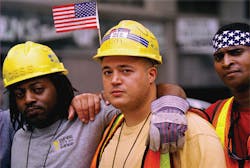Report Says Government Inaction Following 9/11 Contributed to Worker and Resident Illnesses
The New York Committee for Occupational Safety and Health (NYCOSH) has issued a report it claims offers evidence that action – and inaction – by government officials contributed to the toll of death and disease.
Reportedly, thousands of people are suffering from chronic respiratory ailments, cancers and other serious illnesses attributed to exposure to toxins released by the collapse of the World Trade Center. In its report, which includes a preface written by NIOSH Director Dr. John Howard, NYCOSH offers wide-ranging recommendations on steps that government agencies should take to better safeguard safety and health when the next disaster strikes.
“Are We Prepared for the Next 9/11?” highlights decisions made by federal, state and city agencies and officials in the weeks and months after 9/11 that put workers, volunteers, residents and students at risk.
According to the report, government officials sought to create the appearance of a return to normalcy as rapidly as possible, prompting many to ignore or minimize danger. As a result, EPA did not designate the area around Ground Zero as a hazardous waste site, and OSHA did not require hazardous waste training for workers doing cleanup in the area.
EPA Official: Lower Manhattan Should Be a Superfund Site
Instead, the report finds, OSHA implemented “a zero enforcement policy which ultimately fostered rapid removal of debris rather than protection of worker health.”
Congressman: OSHA's 9/11 Response Endangered Workers
Meanwhile, according to the report, real estate and financial interests pressured New York City’s mayor to quickly reopen lower Manhattan – regardless of the health and safety consequences.
As a result, some 400,000 people may have been exposed to contaminants, according to a 2007 mayoral taskforce, and many now suffer the consequences.
U.S. Rep. Jerrold Nadler, whose district includes lower Manhattan, said, “We know now that many mistakes were made in the days and weeks following 9/11 that exposed thousands of New Yorkers and responders from around the country to toxins from the collapse of the WTC buildings.... Many lost their lives and many more still are suffering today. We must all work together to make certain the mistakes made after 9-11 are never repeated, no matter the scale of the disaster or when it comes."
NYCOSH's recommendations for preparing for the next disaster include:
- Do no additional harm: Rescue operations should not expose workers and volunteers to unnecessary risks.
- The federal government should take clear responsibility for public health during disaster response.
- Training should be provided not only to traditional first responders but also day laborers, volunteers and other non-traditional participants.
- Since immigrant workers have been exploited in the responses to many disasters, including 9/11, the federal government must protect these workers' rights to legal wages and a safe and healthy workplace.
- Uniform re-occupancy standards, based on science, not politics, should be established to protect the public health.
- OSHA and EPA should enforce applicable standards and, where no standards apply, ensure the use of safest work practices and the most protective exposure limits.
“For all of us in the public and private sectors who have a role in preventing injuries, illnesses and deaths associated with disasters on an immense scale, the recommendations in the NYCOSH report are pertinent to issues that are vital for us to consider,” Dr. John Howard, director of the National Institute for Occupational Safety and Health (NIOSH), wrote in his preface to the report.
About the Author

Sandy Smith
Sandy Smith is the former content director of EHS Today, and is currently the EHSQ content & community lead at Intelex Technologies Inc. She has written about occupational safety and health and environmental issues since 1990.
